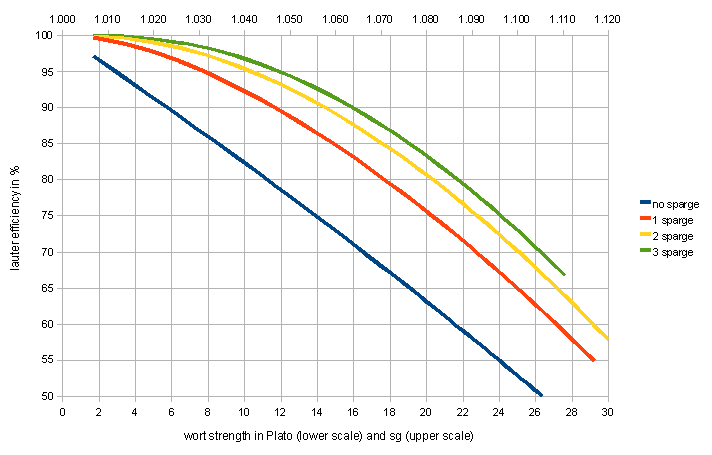So I'm trying to formulate a no sparge version of Jamil Zainascheff's English Barleywine recipe and I'm confused. The two methods of calculating no sparge scale factors in Palmers book give very different results. JZ's recipe has 20.4 lbs of grain with an average FGDB congress yield of 36.7 ppg for a total of 748 pts. He says to collect 7.1 gallons with a boil gravity of 1.070 so thats 497 points which he then boils down to 5 gallons at 1.100. That gives an extract efficiency of 66%. When I do a no sparge mash my extract efficiency is usually about 62% so I obviously need more grain and there are two ways to calculate it. If I do it based on my efficiency I get the following. I want to end the 2 hour boil with 5.5 gallons at 1.100 so thats 550 pts. I want to start the boil with 7.5 gallons so thats a boil gravity of 1.073. If I want to collect 550 points and I usually get 62% then I need 887 points in the mash. So if my mash needs 887 points and the recipe has 748 points in it, it seems like I should scale the grain bill by 887/748 which is 1.186. So instead of his 20.4 lbs I'll need 24.2 lbs of grain. That seems fine. But if I use the "long way" calc from palmers book which is based on this derivation: http://home.roadrunner.com/~brewbeer/files/nbsparge.html it tells me I need to scale up the grain bill by 1.52 which is 31 lbs of grain! Thats quite a difference. I've read that derivation and it makes sense to me, but so does the efficiency approach that I described above. Which is right?
You are using an out of date browser. It may not display this or other websites correctly.
You should upgrade or use an alternative browser.
You should upgrade or use an alternative browser.
No Sparge Calculation Help
- Thread starter McCue
- Start date

Help Support Homebrew Talk - Beer, Wine, Mead, & Cider Brewing Discussion Forum:
This site may earn a commission from merchant affiliate
links, including eBay, Amazon, and others.
JuanMoore
Getting the banned back together
Which is right?
I didn't read the entire "long way" formulation, but scaling up by 1.52 seems high to me, although it's probably more accurate. I'm guessing you'll miss your gravity if you use the efficiency scaling that you outlined. The reason is that your 62% is likely based on med gravity brews, and your efficiency will suffer as the OG goes up. Have you done no sparge brews with pre-boil gravities this high before? There are variables unique to everyones system and process that the formulas can't account for, so it's hard to say which one will get you closer to your goal. Sorry I couldn't be more help.
The reason is that your 62% is likely based on med gravity brews, and your efficiency will suffer as the OG goes up.
Illustrated, by Kai Troester:

JuanMoore
Getting the banned back together
Illustrated, by Kai Troester:
A picture is worth a thousand words...

That is a great graph, where did it come from? You guys are right, 62% is for medium gravity brews and I haven't ever done something this high before. On the graph I'm assuming that the gravity it's talking about it pre boil gravity. In that case it seems to suggest higher efficiencies than most people usually get. For example the pre boil gravity in this case is around 1.070 and the graph shows efficiency of around 80% for a single batch sparge. The JZ recipie uses a fly sparge which should be higher than batch and he's only predicting 66%. Any idea why the big difference? I understand that the conclusion is still the same. If I'm getting 62% with pre boil gravities around 1.040 then I'll get less at 1.070 and that's why I should use the "long way" calc even though thats too much grain for my mash tun. I guess I'll just do a smaller batch.
Similar threads
- Replies
- 3
- Views
- 448
- Replies
- 13
- Views
- 440
- Replies
- 30
- Views
- 950
- Replies
- 5
- Views
- 603

